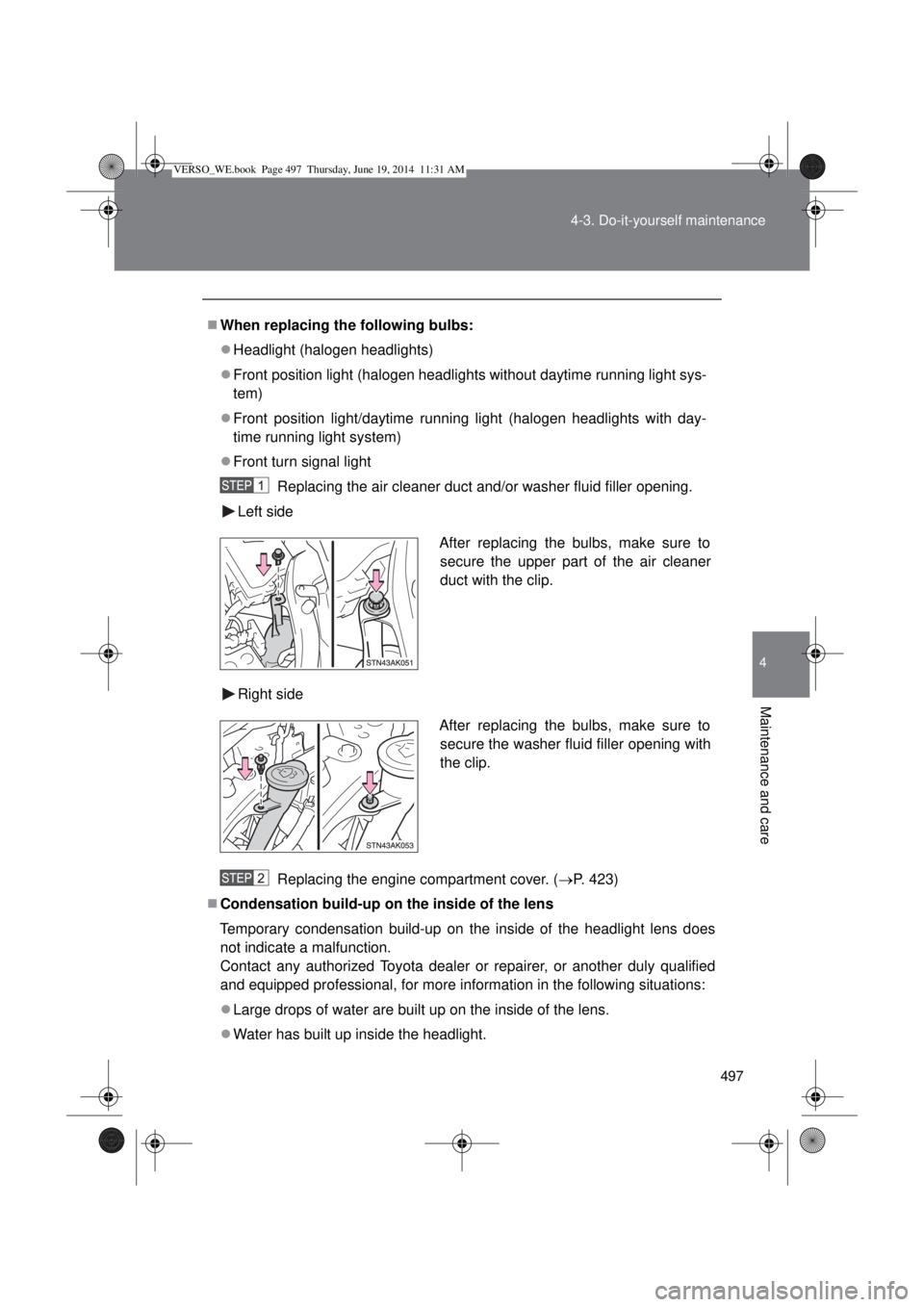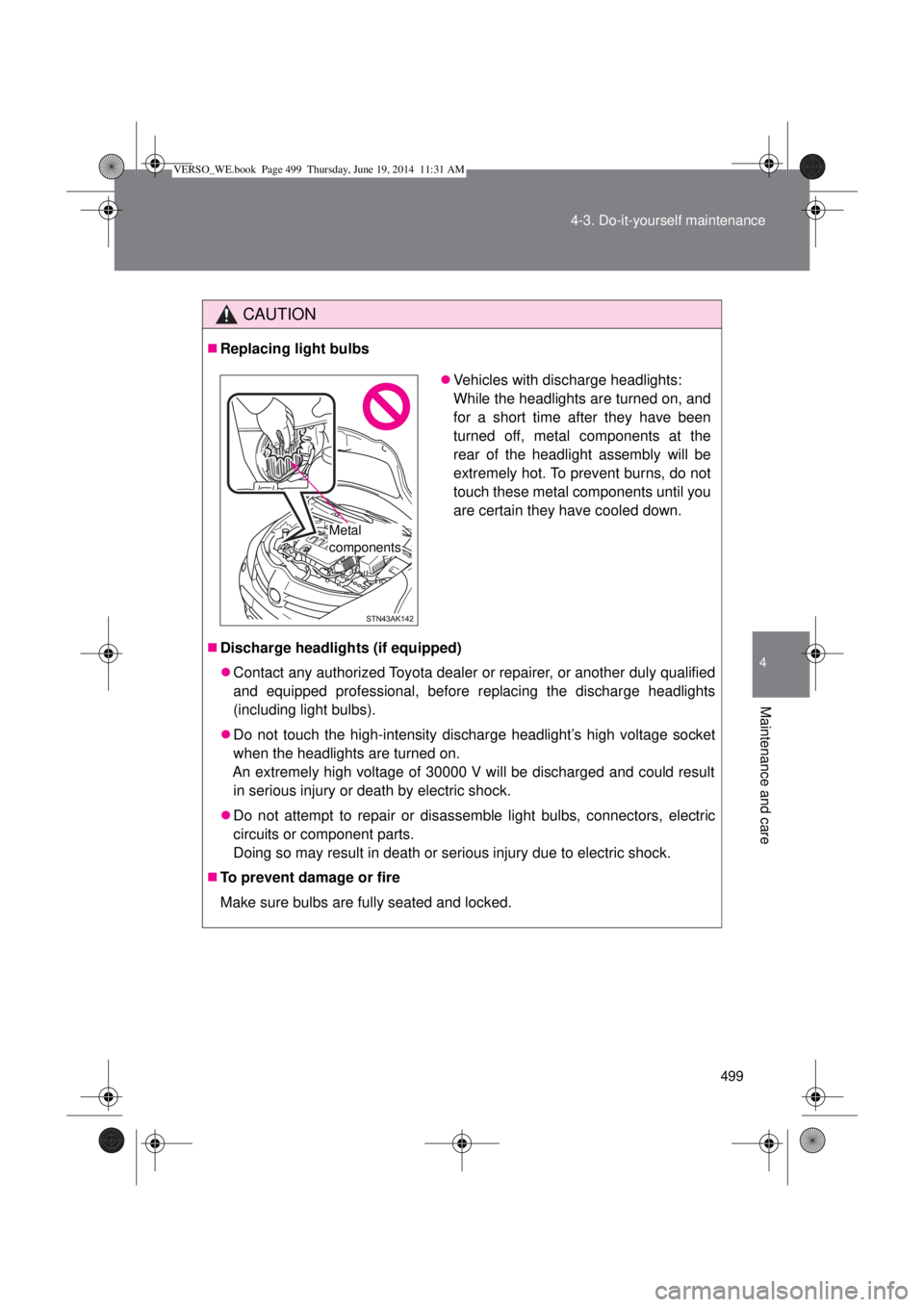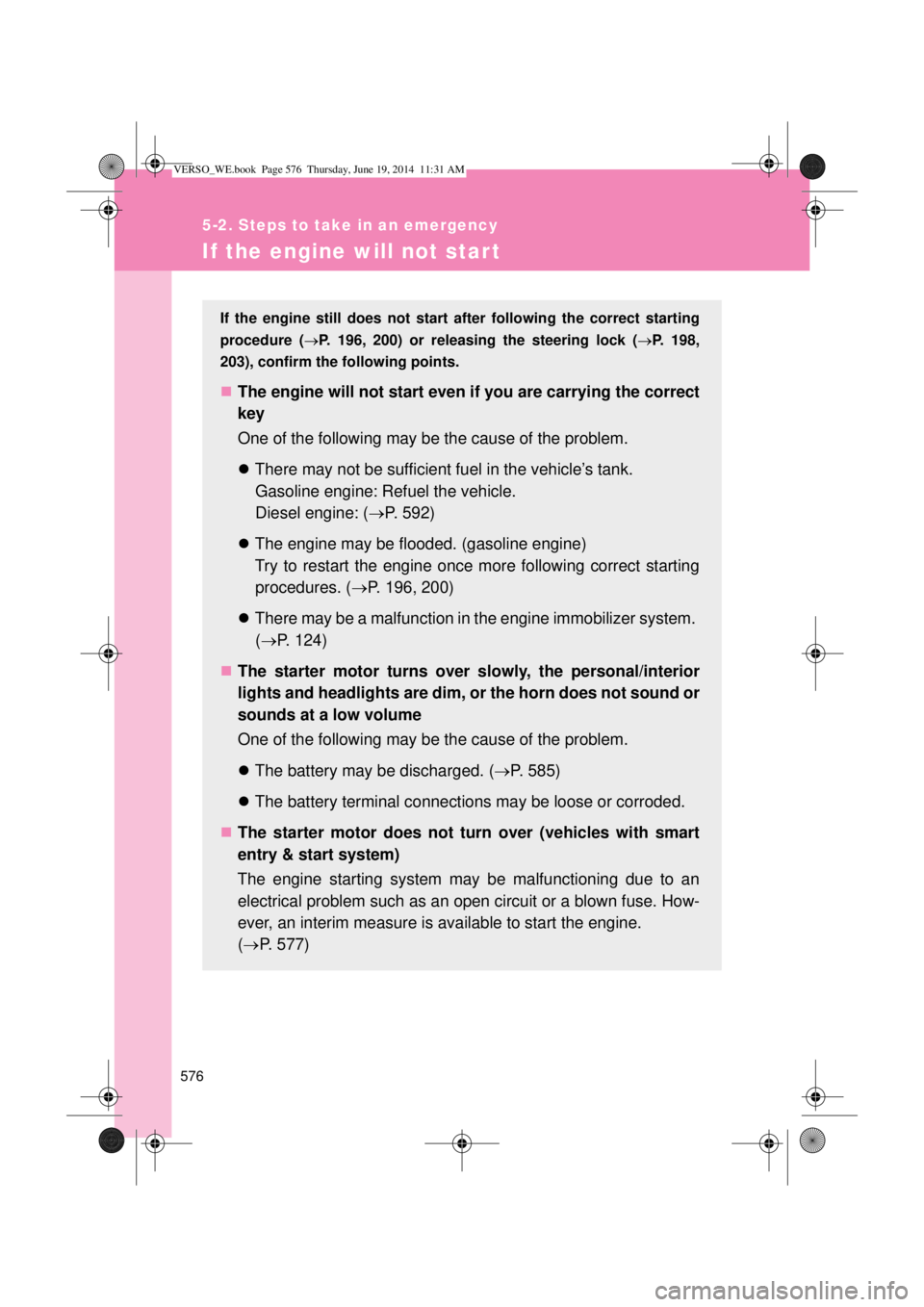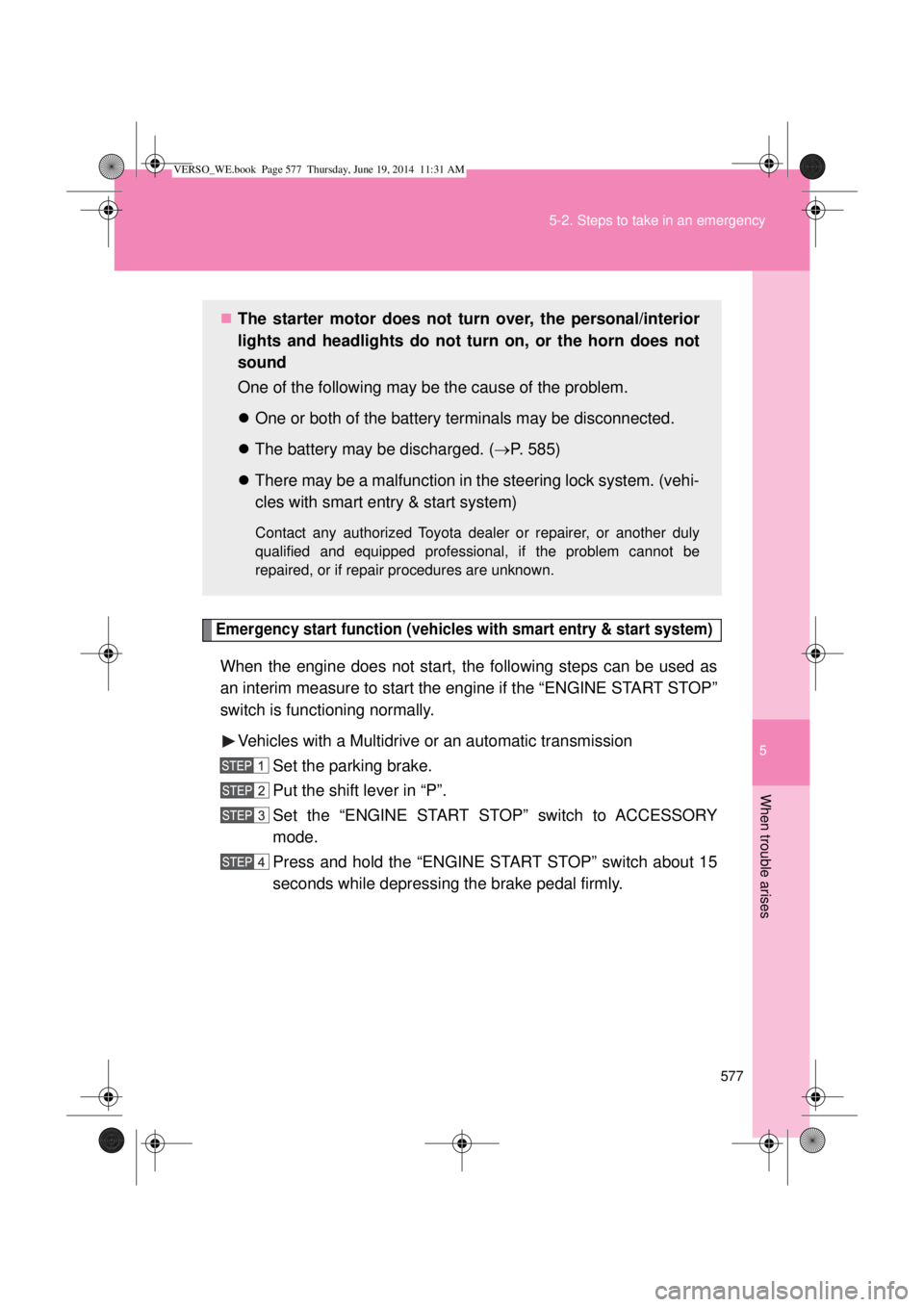Page 489 of 650
489 4-3. Do-it-yourself maintenance
4
Maintenance and care
Install and turn the cover to the
closed position.
Closed position
After replacing the light bulb, replace the air cleaner duct and/
or washer fluid filler opening by conducting . (P. 497)
Headlight high beam (halogen headlights)
Turn the cover to the open posi-
tion and remove it.
Open position
VERSO_WE.book Page 489 Thursday, June 19, 2014 11:31 AM
Page 493 of 650
493 4-3. Do-it-yourself maintenance
4
Maintenance and care
When installing the fender liner, install by conducting
with the directions reversed.
Front position light (halogen headlights without daytime run-
ning light system), front position light/daytime running light
(halogen headlights with daytime running light system)
Turn the bulb base counterclock-
wise.
Remove the light bulb.
VERSO_WE.book Page 493 Thursday, June 19, 2014 11:31 AM
Page 496 of 650
496 4-3. Do-it-yourself maintenance
License plate light
Remove the cover.
Insert a properly sized screw-
driver into the hole of the cover,
and ply off the cover as shown in
the illustration.
To prevent damaging the vehicle,
wrap the screwdriver with a tape.
Remove the light bulb.
Lights other than the above
If any of the lights listed below has burnt out, have it replaced by
any authorized Toyota dealer or repairer, or another duly qualified
and equipped professional.
Headlights (discharge headlights)
Front position lights/daytime running lights (discharge head-
lights)
Side turn signal lights
High mounted stoplight
Stop lights
VERSO_WE.book Page 496 Thursday, June 19, 2014 11:31 AM
Page 497 of 650

497 4-3. Do-it-yourself maintenance
4
Maintenance and care
When replacing the following bulbs:
Headlight (halogen headlights)
Front position light (halogen headlights without daytime running light sys-
tem)
Front position light/daytime running light (halogen headlights with day-
time running light system)
Front turn signal light
Replacing the air cleaner duct and/or washer fluid filler opening.
Left side
Right side
Replacing the engine compartment cover. (P. 423)
Condensation build-up on the inside of the lens
Temporary condensation build-up on the inside of the headlight lens does
not indicate a malfunction.
Contact any authorized Toyota dealer or repairer, or another duly qualified
and equipped professional, for more information in the following situations:
Large drops of water are built up on the inside of the lens.
Water has built up inside the headlight.
After replacing the bulbs, make sure to
secure the upper part of the air cleaner
duct with the clip.
After replacing the bulbs, make sure to
secure the washer fluid filler opening with
the clip.
VERSO_WE.book Page 497 Thursday, June 19, 2014 11:31 AM
Page 498 of 650

498 4-3. Do-it-yourself maintenance
Discharge headlights (if equipped)
If voltage to the discharge bulbs is insufficient, the bulbs may not come on,
or may go out temporarily. The discharge bulbs will come on when normal
power is restored.
LED light bulbs
The front position lights/daytime running lights (discharge headlights), stop
lights and high mounted stoplight consist of a number of LEDs. If any of the
LEDs burn out, take your vehicle to any authorized Toyota dealer or repairer,
or another duly qualified and equipped professional to have the light
replaced.
If two or more LEDs in a stop light burn out, your vehicle may not conform to
local laws (ECE).
When replacing light bulbs
P. 482
CAUTION
Replacing light bulbs
Turn off the lights. Do not attempt to replace the bulb immediately after
turning off the lights.
The bulbs become very hot and may cause burns.
Do not touch the glass portion of the light bulb with bare hands.
When it is unavoidable to hold the glass portion, use and hold with a clean
dry cloth to avoid getting moisture and oils on the bulb.
Also, if the bulb is scratched or dropped, it may blow out or crack.
Fully install light bulbs and any parts used to secure them. Failing to do so
may result in heat damage, fire, or water entering the headlight unit. This
may damage the headlights or cause condensation to build up on the lens.
VERSO_WE.book Page 498 Thursday, June 19, 2014 11:31 AM
Page 499 of 650

499 4-3. Do-it-yourself maintenance
4
Maintenance and care
CAUTION
Replacing light bulbs
Discharge headlights (if equipped)
Contact any authorized Toyota dealer or repairer, or another duly qualified
and equipped professional, before replacing the discharge headlights
(including light bulbs).
Do not touch the high-intensity discharge headlight’s high voltage socket
when the headlights are turned on.
An extremely high voltage of 30000 V will be discharged and could result
in serious injury or death by electric shock.
Do not attempt to repair or disassemble light bulbs, connectors, electric
circuits or component parts.
Doing so may result in death or serious injury due to electric shock.
To prevent damage or fire
Make sure bulbs are fully seated and locked.
Vehicles with discharge headlights:
While the headlights are turned on, and
for a short time after they have been
turned off, metal components at the
rear of the headlight assembly will be
extremely hot. To prevent burns, do not
touch these metal components until you
are certain they have cooled down.
Metal
components
VERSO_WE.book Page 499 Thursday, June 19, 2014 11:31 AM
Page 576 of 650

576
5-2. Steps to take in an emergency
If the engine will not start
If the engine still does not start after following the correct starting
procedure (P. 196, 200) or releasing the steering lock (P. 198,
203), confirm the following points.
The engine will not start even if you are carrying the correct
key
One of the following may be the cause of the problem.
There may not be sufficient fuel in the vehicle’s tank.
Gasoline engine: Refuel the vehicle.
Diesel engine: (P. 592)
The engine may be flooded. (gasoline engine)
Try to restart the engine once more following correct starting
procedures. (P. 196, 200)
There may be a malfunction in the engine immobilizer system.
(P. 124)
The starter motor turns over slowly, the personal/interior
lights and headlights are dim, or the horn does not sound or
sounds at a low volume
One of the following may be the cause of the problem.
The battery may be discharged. (P. 585)
The battery terminal connections may be loose or corroded.
The starter motor does not turn over (vehicles with smart
entry & start system)
The engine starting system may be malfunctioning due to an
electrical problem such as an open circuit or a blown fuse. How-
ever, an interim measure is available to start the engine.
(P. 577)
VERSO_WE.book Page 576 Thursday, June 19, 2014 11:31 AM
Page 577 of 650

5
577 5-2. Steps to take in an emergency
When trouble arises
Emergency start function (vehicles with smart entry & start system)
When the engine does not start, the following steps can be used as
an interim measure to start the engine if the “ENGINE START STOP”
switch is functioning normally.
Vehicles with a Multidrive or an automatic transmission
Set the parking brake.
Put the shift lever in “P”.
Set the “ENGINE START STOP” switch to ACCESSORY
mode.
Press and hold the “ENGINE START STOP” switch about 15
seconds while depressing the brake pedal firmly.
The starter motor does not turn over, the personal/interior
lights and headlights do not turn on, or the horn does not
sound
One of the following may be the cause of the problem.
One or both of the battery terminals may be disconnected.
The battery may be discharged. (P. 585)
There may be a malfunction in the steering lock system. (vehi-
cles with smart entry & start system)
Contact any authorized Toyota dealer or repairer, or another duly
qualified and equipped professional, if the problem cannot be
repaired, or if repair procedures are unknown.
VERSO_WE.book Page 577 Thursday, June 19, 2014 11:31 AM